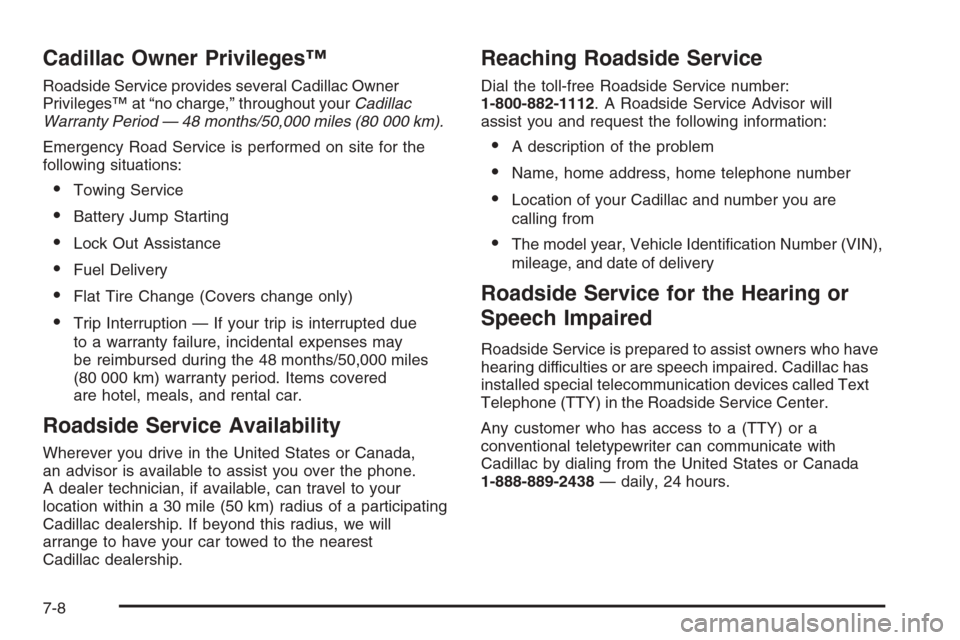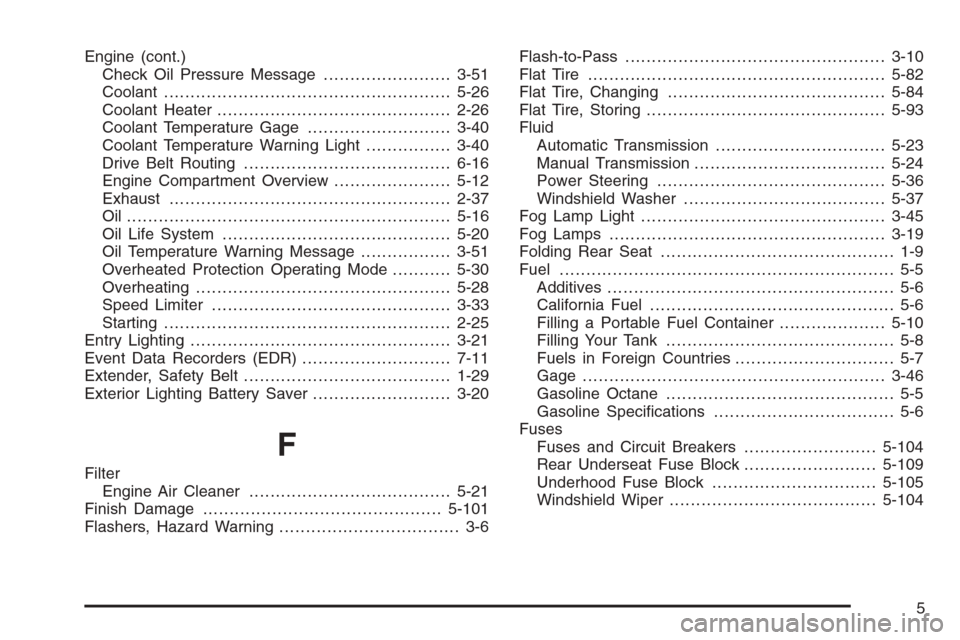ECO mode CADILLAC CTS V 2006 1.G Owner's Manual
[x] Cancel search | Manufacturer: CADILLAC, Model Year: 2006, Model line: CTS V, Model: CADILLAC CTS V 2006 1.GPages: 442, PDF Size: 2.57 MB
Page 337 of 442

Outward Facing Sidewall:The side of an
asymmetrical tire that has a particular side that faces
outward when mounted on a vehicle. The side of the
tire that contains a whitewall, bears white lettering,
or bears manufacturer, brand, and/or model name
molding that is higher or deeper than the same moldings
on the other sidewall of the tire.
Passenger (P-Metric) Tire:A tire used on passenger
cars and some light duty trucks and multipurpose
vehicles.
Recommended In�ation Pressure:Vehicle
manufacturer’s recommended tire in�ation pressure as
shown on the tire placard. SeeIn�ation - Tire Pressure
on page 5-65andLoading Your Vehicle on page 4-32.
Radial Ply Tire:A pneumatic tire in which the ply cords
that extend to the beads are laid at 90 degrees to the
centerline of the tread.
Rim:A metal support for a tire and upon which the tire
beads are seated.
Sidewall:The portion of a tire between the tread and
the bead.
Speed Rating:An alphanumeric code assigned to a
tire indicating the maximum speed at which a tire
can operate.
Traction:The friction between the tire and the road
surface. The amount of grip provided.Tread:The portion of a tire that comes into contact
with the road.
Treadwear Indicators:Narrow bands, sometimes
called wear bars, that show across the tread of a tire
when only 1/16 inch (1.6 mm) of tread remains.
SeeWhen It Is Time for New Tires on page 5-72.
UTQGS (Uniform Tire Quality Grading Standards):
A tire information system that provides consumers
with ratings for a tire’s traction, temperature, and
treadwear. Ratings are determined by tire manufacturers
using government testing procedures. The ratings are
molded into the sidewall of the tire. SeeUniform
Tire Quality Grading on page 5-75.
Vehicle Capacity Weight:The number of designated
seating positions multiplied by 150 lbs (68 kg) plus
the rated cargo load. SeeLoading Your Vehicle
on page 4-32.
Vehicle Maximum Load on the Tire:Load on an
individual tire due to curb weight, accessory weight,
occupant weight, and cargo weight.
Vehicle Placard:A label permanently attached to a
vehicle showing the vehicle’s capacity weight and
the original equipment tire size and recommended
in�ation pressure. See “Tire and Loading Information
Label” underLoading Your Vehicle on page 4-32.
5-63
Page 418 of 442

Cadillac Owner Privileges™
Roadside Service provides several Cadillac Owner
Privileges™ at “no charge,” throughout yourCadillac
Warranty Period — 48 months/50,000 miles (80 000 km).
Emergency Road Service is performed on site for the
following situations:
Towing Service
Battery Jump Starting
Lock Out Assistance
Fuel Delivery
Flat Tire Change (Covers change only)
Trip Interruption — If your trip is interrupted due
to a warranty failure, incidental expenses may
be reimbursed during the 48 months/50,000 miles
(80 000 km) warranty period. Items covered
are hotel, meals, and rental car.
Roadside Service Availability
Wherever you drive in the United States or Canada,
an advisor is available to assist you over the phone.
A dealer technician, if available, can travel to your
location within a 30 mile (50 km) radius of a participating
Cadillac dealership. If beyond this radius, we will
arrange to have your car towed to the nearest
Cadillac dealership.
Reaching Roadside Service
Dial the toll-free Roadside Service number:
1-800-882-1112. A Roadside Service Advisor will
assist you and request the following information:
A description of the problem
Name, home address, home telephone number
Location of your Cadillac and number you are
calling from
The model year, Vehicle Identi�cation Number (VIN),
mileage, and date of delivery
Roadside Service for the Hearing or
Speech Impaired
Roadside Service is prepared to assist owners who have
hearing difficulties or are speech impaired. Cadillac has
installed special telecommunication devices called Text
Telephone (TTY) in the Roadside Service Center.
Any customer who has access to a (TTY) or a
conventional teletypewriter can communicate with
Cadillac by dialing from the United States or Canada
1-888-889-2438— daily, 24 hours.
7-8
Page 421 of 442

Vehicle Data Collection and Event
Data Recorders
Your vehicle, like other modern motor vehicles, has a
number of sophisticated computer systems that monitor
and control several aspects of the vehicle’s performance.
Your vehicle uses on-board vehicle computers to monitor
emission control components to optimize fuel economy,
to monitor conditions for airbag deployment and, if the
vehicle has the Anti-lock Brake System (ABS), to provide
anti-lock braking and to help the driver control the vehicle
in difficult driving situations. Some information may be
stored during regular operations to facilitate repair of
detected malfunctions; other information is stored only in
a crash event by computer systems, such as those
commonly called Event Data Recorders (EDR).
In a crash event, computer systems, such as the
airbag Sensing and Diagnostic Module (SDM) in your
vehicle may record information about the condition of the
vehicle and how it was operated, such as data related
to engine speed, brake application, throttle position,
vehicle speed, safety belt usage, airbag readiness,
airbag performance, and the severity of a collision.
This information has been used to improve vehicle
crash performance and may be used to improve crash
performance of future vehicles and driving safety.Unlike the data recorders on many airplanes, these
on-board systems do not record sounds, such as
conversation of vehicle occupants.
To read this information, special equipment is needed
and access to the vehicle or the device that stores
the data is required. GM will not access information
about a crash event or share it with others other than:
with the consent of the vehicle owner or, if the
vehicle is leased, with the consent of the lessee,
in response to an official request of police or similar
government office,
as part of GM’s defense of litigation through the
discovery process, or
as required by law.
In addition, once GM collects or receives data, GM may:
use the data for GM research needs,
make it available for research where appropriate
con�dentiality is to be maintained and need is
shown, or
share summary data which is not tied to a speci�c
vehicle with non-GM organizations for research
purposes.
7-11
Page 424 of 442

Gather the important information you will need from
the other driver. Things like name, address, phone
number, driver’s license number, vehicle license
plate, vehicle make, model and model year, Vehicle
Identi�cation Number (VIN), insurance company and
policy number, and a general description of the
damage to the other vehicle.
If possible, call your insurance company from the
scene of the accident. They will walk you through
the information they will need. If they ask for a
police report, phone or go to the police department
headquarters the next day and you can get a copy of
the report for a nominal fee. In some states/provinces
with “no fault” insurance laws, a report may not be
necessary. This is especially true if there are no
injuries and both vehicles are driveable.
Choose a reputable collision repair facility for your
vehicle. Whether you select a GM dealer or a
private collision repair facility to �x the damage,
make sure you are comfortable with them.
Remember, you will have to feel comfortable with
their work for a long time.
Once you have an estimate, read it carefully and
make sure you understand what work will be
performed on your vehicle. If you have a question,
ask for an explanation. Reputable shops welcome
this opportunity.
Managing the Vehicle Damage
Repair Process
In the event that your vehicle requires damage repairs,
GM recommends that you take an active role in its
repair. If you have a pre-determined repair facility of
choice, take your vehicle there, or have it towed there.
Specify to the facility that any required replacement
collision parts be original equipment parts, either
new Genuine GM parts or recycled original GM parts.
Remember, recycled parts will not be covered by
your GM vehicle warranty.
Insurance pays the bill for the repair, but you must
live with the repair. Depending on your policy limits,
your insurance company may initially value the repair
using aftermarket parts. Discuss this with your repair
professional, and insist on Genuine GM parts.
Remember if your vehicle is leased you may be
obligated to have the vehicle repaired with Genuine
GM parts, even if your insurance coverage does not pay
the full cost.
If another party’s insurance company is paying for
the repairs, you are not obligated to accept a repair
valuation based on that insurance company’s collision
policy repair limits, as you have no contractual limits with
that company. In such cases, you can have control of
the repair and parts choices as long as cost stays within
reasonable limits.
7-14
Page 433 of 442

Engine (cont.)
Check Oil Pressure Message........................3-51
Coolant......................................................5-26
Coolant Heater............................................2-26
Coolant Temperature Gage...........................3-40
Coolant Temperature Warning Light................3-40
Drive Belt Routing.......................................6-16
Engine Compartment Overview......................5-12
Exhaust.....................................................2-37
Oil .............................................................5-16
Oil Life System...........................................5-20
Oil Temperature Warning Message.................3-51
Overheated Protection Operating Mode...........5-30
Overheating................................................5-28
Speed Limiter.............................................3-33
Starting......................................................2-25
Entry Lighting.................................................3-21
Event Data Recorders (EDR)............................7-11
Extender, Safety Belt.......................................1-29
Exterior Lighting Battery Saver..........................3-20
F
Filter
Engine Air Cleaner......................................5-21
Finish Damage.............................................5-101
Flashers, Hazard Warning.................................. 3-6Flash-to-Pass.................................................3-10
Flat Tire........................................................5-82
Flat Tire, Changing.........................................5-84
Flat Tire, Storing.............................................5-93
Fluid
Automatic Transmission................................5-23
Manual Transmission....................................5-24
Power Steering...........................................5-36
Windshield Washer......................................5-37
Fog Lamp Light..............................................3-45
Fog Lamps ....................................................3-19
Folding Rear Seat............................................ 1-9
Fuel............................................................... 5-5
Additives...................................................... 5-6
California Fuel.............................................. 5-6
Filling a Portable Fuel Container....................5-10
Filling Your Tank........................................... 5-8
Fuels in Foreign Countries.............................. 5-7
Gage .........................................................3-46
Gasoline Octane........................................... 5-5
Gasoline Speci�cations.................................. 5-6
Fuses
Fuses and Circuit Breakers.........................5-104
Rear Underseat Fuse Block.........................5-109
Underhood Fuse Block...............................5-105
Windshield Wiper.......................................5-104
5
Page 439 of 442

Safety Belts (cont.)
Questions and Answers About Safety Belts........1-15
Rear Safety Belt Comfort Guides...................1-26
Rear Seat Passengers.................................1-23
Right Front Passenger Position......................1-23
Safety Belt Extender....................................1-29
Safety Belt Use During Pregnancy.................1-22
Safety Belts Are for Everyone.......................1-11
Safety Warnings and Symbols.............................. iii
Scheduled Maintenance..................................... 6-4
Seats
Head Restraints............................................ 1-8
Heated Seats............................................... 1-4
Manual........................................................ 1-2
Memory .....................................................2-52
Power Lumbar .............................................. 1-3
Power Seats................................................. 1-3
Reclining Seatbacks...................................... 1-5
Split Folding Rear Seat.................................. 1-9
Securing a Child Restraint
Rear Seat Position......................................1-48
Right Front Seat Position..............................1-50
Security Light.................................................3-45
Service........................................................... 5-3
Accessories and Modi�cations......................... 5-3
Adding Equipment to the Outside of
Your Vehicle.............................................. 5-5
California Proposition 65 Warning.................... 5-3Service (cont.)
Doing Your Own Work................................... 5-4
Engine Soon Light.......................................3-41
Publications Ordering Information...................7-16
Servicing Your Airbag-Equipped Vehicle..............1-67
Setting the Time.............................................3-85
Sheet Metal Damage.....................................5-100
Shift, One-to-Four Message..............................3-52
Shifting Into Park (P).......................................2-34
Shifting Out of Park (P)...................................2-36
Signals, Turn and Lane-Change.......................... 3-9
Spare Tire
Compact....................................................5-94
Installing....................................................5-87
Removing...................................................5-85
Storing.......................................................5-93
Speci�cations, Capacities...............................5-115
Speedometer..................................................3-33
Split Folding Rear Seat..................................... 1-9
Sport Mode Light............................................3-45
StabiliTrak
®System.........................................4-12
Starting Your Engine.......................................2-25
Status of Vehicle Systems, DIC........................3-54
Steering........................................................4-13
Steering Wheel Comfort Controls......................3-30
Steering Wheel Controls, Audio.......................3-102
Steering Wheel, Recon�gurable
Steering Wheel Controls................................. 3-7
11